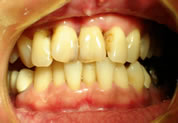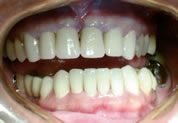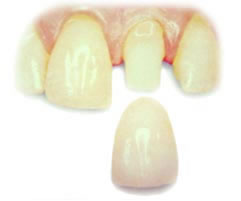As we get older, many of us discover that our teeth that are no longer as structurally sound as they were in our youth. Your regular dentist will usually be able to recognize problem areas which may lead to tooth damage and a need for dental crowns.
Grinding your teeth, an improper bite, age, fillings and tooth decay are all contributing factors in the erosion, cracking or breakage of your teeth. If the entire surface of the tooth is damaged, but the root system has remained intact, your dentist will usually suggest that a dental crown be put in place.
Dental crowns are also capable of replacing missing teeth entirely. The dental crown is secured to the teeth on either side using a bridge section which connects the two dental crowns. Alternatively, single tooth dental implants can be placed. This eliminates the need for supporting the dental crowns so no bridge is required.
Our dentist may recommend the placement of a dental crown for a wide range of problems but, in general, the majority of these reasons usually fall within one of the following basic categories:
The restoration of a tooth to its original shape.
The strengthening of a weak tooth.
To improve the esthetic appearance of a tooth.

The procedure of dental crowns
The first step is for your dentist to make an impression of the tooth. This is taken to a dental laboratory where a custom-made crown is fashioned. A temporary crown is installed and you will wear this until the permanent crown has been made which usually takes about two weeks. However we can speed up to 2-7 days if requested.
When you return for your second appointment the permanent crown will be cemented onto your tooth. The crown should last for ten to fifteen years.
The placement of a crown can usually be completed with only two appointments.

Before

After
The initial dental crown appointment
- Your dentist will numb your tooth.
- Your dentist will shape your tooth.
- Your dentist will make an impression of your tooth.
- A temporary dental crown will be made for your tooth.
- Your dentist will select the proper shade of porcelain needed for your dental crown.
Your second dental crown appointment
- Permanent crown is cemented in place.
Types of dental crowns
Dental Crowns made of Resin and Porcelain

The new reinforced resin or bonded all-porcelain type of dental crowns has the most natural appearance as the color is specifically chosen to match the color of your teeth. They can be made from pure ceramic or a new reinforced composite resin, and as they are almost indistinguishable from natural teeth they are used primarily for front teeth. Unsurprisingly, more and more patients are also requesting them for other areas of the mouth.
They are bonded using material which is metal-free which is of great benefit to patients with metal sensitivities.
There are basically two types of porcelain. The felspathic type is the original method that has been around for 20 years.
The other method is pressed ceramic porcelain which is created from single ingot. This is milled in one piece to create the required shape. Stains and opaques are applied only to the surface of the porcelain.
Advantages and Disadvantages of resin and porcelain crowns
Advantages
- Porcelain crowns are undoubtedly the most esthetically pleasing, as their color is specifically chosen to match your natural teeth.
- They are metal free.
Disadvantages
- It is necessary to remove more tooth structure because of the thickness of the porcelain.
- The thickness of the porcelain also means it is more difficult to get an ideal fit where your gum meets the crown.
- Gingival inflammation appears to be more common with porcelain crowns than gold crowns.
- Porcelain crowns require a higher skill level from your dentist.



